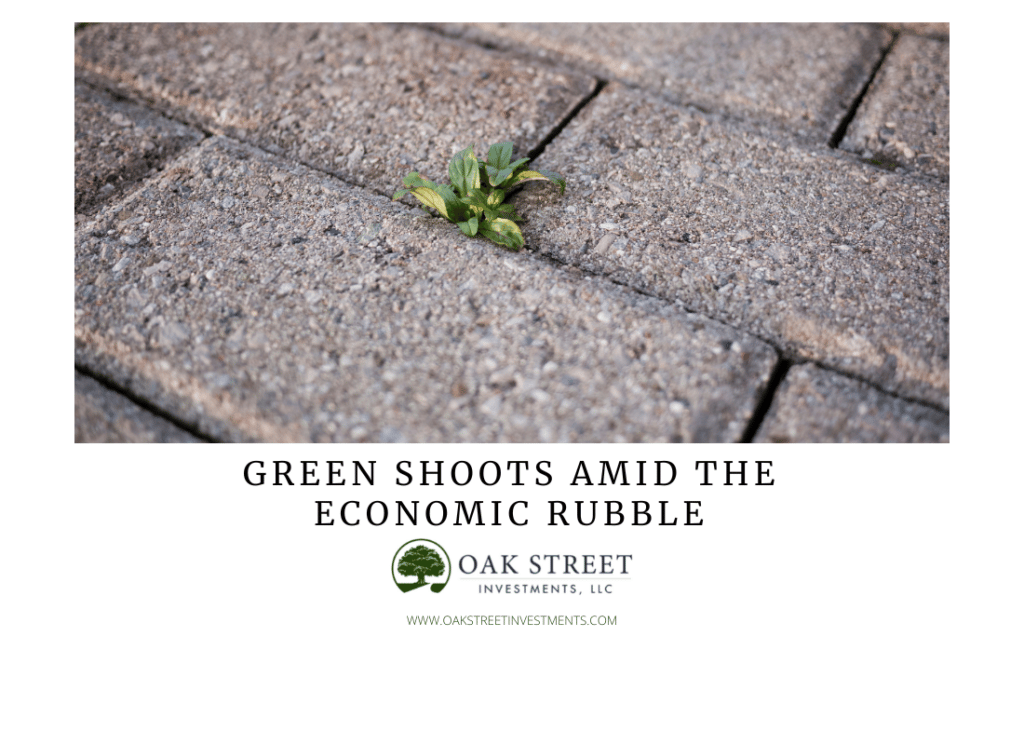
Green Shoots Amid the Economic Rubble
My apologies for the delay in getting this 3rd quarter review out. I was busy combing through the financial rubble that is the global economy for some glimmer of hope, and it turns out there are some sprouts beginning to grow. But first, the storm.
For the 3rd quarter, US markets were off 4.46%, with the international developed equity markets off over twice that at 9.2%, and emerging markets even worse – and those weren’t even the most surprising numbers. Global real estate, as measured by the S&P Global REIT index, was off over 11% and the US Aggregate Bond index finished the quarter down even more than US Equities, down 4.75% as interest rates continued to rise (bond prices move inversely to interest rates). While this newsletter will try to highlight some good news, recent models by Bloomberg Economists put the odds of a US Recession within one year at near 100%!
So, what about those green shoots?
In a recent conversation with a relative, they were surprised to hear that I’m more optimistic now about the markets (not the economy) than I was a year ago. Sure, they’ve taken a beating now, but as I’ve written previously, the lower the markets the higher the expected return. We know the economy will likely fall into a recession, and I’m certainly not calling a market bottom here – we could have another wave of pain coming, but that doesn’t change that the more the market sells off, the higher the expected returns and the shorter the amount of time it should take for you to recoup your investment. Remember, that while the market may overshoot its fair/intrinsic value on the way down ( just as it did on the way up) it’s extremely difficult to time when things will turn around, and history tells us that these turnarounds can be quick and significant. We also know that missing just a few of these big up days by sitting on the sidelines can have significant, detrimental effects on a portfolio.
If you have cash and/or are working and contributing to your accounts, view the selloff as an opportunity. If you’re retired and/or withdrawing from your accounts, hopefully you’ve bucketed out what’s needed for the next couple of years and that’s in safe, liquid investments so you don’t need to pull from the portion of your portfolio that’s significantly down. A byproduct of the pain we’ve experienced this year in the bond market (the aggregate bond index is down over 16% as of this writing) is that yields are now significantly higher than they’ve been in a decade. “Risk-Free” T-Bills, short term debt issued by the US Government are now yielding 4%!
I know you’re not reading the financial headlines or watching the financial news (you did turn it off, right??) but things are looking grim. It’s hard to find good news in the headlines so I wanted to share some articles and reasons to begin feeling more confident, particularly around slowing inflation:
- At -23%, the S&P500 return year-to-date (as of mid October) is down almost exactly what the median market drawdown has been since 1950 at 24%. The average recession downturn is 29%. Obviously, as stated above, markets will likely and often overshoot, but this should provide some perspective.
- Since 1950, buying stocks after they’ve been down 20% from record highs has been a good risk/reward for long-term investors, with the s&p500 higher three years later in 8 out of 9 cases, and an average return of 29%! To be sure, it’s usually a rocky year to 18 months from the 20% selloff, but long term investors have been rewarded.
- According to a recent survey from AAII, the percentage of investors that are bearish on the market is over 60%, a number that hasn’t been seen since March of 2009, a notably wonderful time to invest. As a contrarian indicator, I love seeing overwhelmingly bearish sentiment.
- If you have 5 minutes and like watching near-octogenarians get deeply upset about economic policy and the actions (or inaction) of the Federal Reserve, I’d highly suggest you watch this interview with Jeremy Siegel, a highly respected academic who believes inflation is currently in check for many goods and services (mostly lagging indicators) and that Fed policy is lagging real, current market conditions.
- A supporting article can be found here, though this one may be for those who have already taken ECON 101.
Yes, the economic landscape looks grim with a near-certain (and maybe the most planned-for) recession coming. But that doesn’t mean this is a good time to sell and abandon hope. As I write in virtually every quarterly newsletter, I’m not sure where things will be in 6 or 12 months, but I’m confident that if you have an investment timeframe of at least a few years (sometimes more when markets are higher, less after a selloff) you may want to start taking a closer look. If not, at least T-Bills are now paying over 4%!
